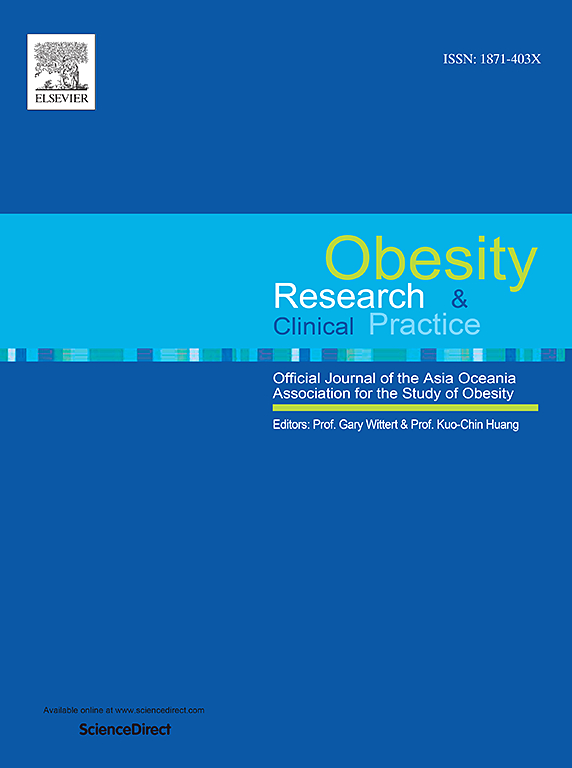Tackling suboptimal clinical response after metabolic bariatric surgery: Impact of tirzepatide on weight loss and body composition
IF 2.5
4区 医学
Q3 ENDOCRINOLOGY & METABOLISM
引用次数: 0
Abstract
Introduction
Insufficient weight loss (IWL) or weight regain (WR) after metabolic bariatric surgery remains a challenge in obesity management. Therefore, this study aimed to retrospectively evaluate the impact of adjunctive tirzepatide therapy over 6 months following sleeve gastrectomy (SG) or Roux-en-Y gastric bypass (RYGB).
Methods
Post-bariatric patients without type 2 diabetes with IWL or WR (n = 21) were analyzed. Key outcomes included changes in weight, BMI, waist circumference, body composition, basal metabolism, metabolic markers, and inflammatory markers. Subgroup analyses assessed differences based on sex, surgery type, and classification as IWL or WR. Linear regression was performed to identify predictors of weight loss outcomes.
Results
At 6 months, mean total weight loss was 12.0 % ± 3.4 % (p < 0.001), with significant reductions in BMI, waist circumference, body fat percentage, and HbA1c. Basal metabolism declined proportionally with weight loss. Weight loss ≥ 5 % occurred in 100.0 % of patients, ≥ 10 % in 76.5 %, and ≥ 15 % in 23.5 %. Basal metabolism differences between RYGB and SG patients converged by 6 months. Male and female patients showed comparable weight loss and metabolic adaptation. IWL patients experienced less fat-free mass loss at 3 months compared to WR (p < 0.05). Baseline BMI nadir, prior weight regain, body composition, and chronic inflammation were significant predictors of weight loss outcomes.
Discussion
Tirzepatide treatment significantly enhances weight loss and metabolic health in post-bariatric patients, regardless of surgery type or sex. Differences in fat-free mass loss highlight the need for tailored interventions in IWL and WR groups. Baseline factors, including inflammation and body composition, may help predict treatment success.
解决代谢性减肥手术后的次优临床反应:替西肽对体重减轻和身体成分的影响。
代谢减肥手术后体重减轻不足(IWL)或体重恢复(WR)仍然是肥胖管理的一个挑战。因此,本研究旨在回顾性评估袖式胃切除术(SG)或Roux-en-Y胃旁路术(RYGB)后6个月辅助替西帕肽治疗的影响。方法:对减肥后无2型糖尿病合并IWL或WR的患者(n = 21)进行分析。主要结局包括体重、BMI、腰围、身体组成、基础代谢、代谢标志物和炎症标志物的变化。亚组分析评估了基于性别、手术类型和IWL或WR分类的差异。采用线性回归来确定减肥结果的预测因子。结果:6个月时,平均总体重减轻12.0 % ± 3.4 % (p )讨论:替西帕肽治疗可显著改善减肥后患者的体重减轻和代谢健康,无论手术类型或性别。无脂肪质量损失的差异突出了对IWL和WR组进行量身定制干预的必要性。包括炎症和身体成分在内的基线因素可能有助于预测治疗成功。
本文章由计算机程序翻译,如有差异,请以英文原文为准。
求助全文
约1分钟内获得全文
求助全文
来源期刊

Obesity research & clinical practice
医学-内分泌学与代谢
CiteScore
7.10
自引率
0.00%
发文量
80
审稿时长
49 days
期刊介绍:
The aim of Obesity Research & Clinical Practice (ORCP) is to publish high quality clinical and basic research relating to the epidemiology, mechanism, complications and treatment of obesity and the complication of obesity. Studies relating to the Asia Oceania region are particularly welcome, given the increasing burden of obesity in Asia Pacific, compounded by specific regional population-based and genetic issues, and the devastating personal and economic consequences. The journal aims to expose health care practitioners, clinical researchers, basic scientists, epidemiologists, and public health officials in the region to all areas of obesity research and practice. In addition to original research the ORCP publishes reviews, patient reports, short communications, and letters to the editor (including comments on published papers). The proceedings and abstracts of the Annual Meeting of the Asia Oceania Association for the Study of Obesity is published as a supplement each year.
 求助内容:
求助内容: 应助结果提醒方式:
应助结果提醒方式:


